 |
||
|
||
| ||
Today we will deal with the most advanced coolers for Socket processors from the GlobalWin arsenal - the FOP38 and WBK38, we will go deep into their efficiency, as well as into technical characteristics and consumer quality. Features and first impressions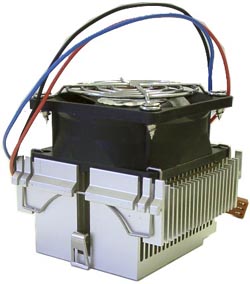 GlobalWin FOP38:
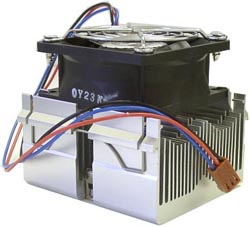 GlobalWin WBK38:
Very good! The coolers impressed me much! First comes the FOP38. The thing is exceptional! An improved (as compared with the FKP32) exclusive heatsink attracts your attention at once. Advanced design, 15 console coefficient (ratio of the fin height to the interfin distance), 20 1-mm fins, high quality anodizing - here are some of its advantages. 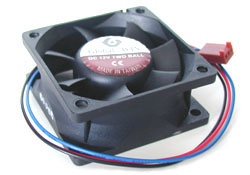 The fan, used in the FOP38, is not less attractive. It is one of the best things from Delta Electronics - the AFB0612EH model. The fan is known for a high rotation speed of the impeller (6800 RPM) and it is one of the leaders in air flow among other 60X60X25 mm fans (besides, it turned to be a leader in the noise level). That's why the company has equipped the fan with a fan guard. 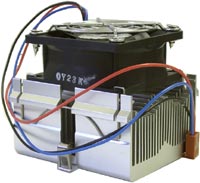 And what about WBK38? It inherited all the best features from the FOP38, and got some new goodies - the fan remained the former, but the heatsink changed a lot. First, dimensions increased (there are 24 fins) and the shape changed. A new cooler is mainly intended for Socket A processors, that's why GlobalWin engineers refused to follow requirements for coolers for the PGA370, which set limitation on the base surface of the heatsink. And secondly, a shape of the base changed also. Note some bulge in its central part - several fins are put closely to the fan. They say that this form allows using an air flow entirely, and reducing the thermal resistance. All this leads to some decreasing of the total thermal resistance of the system "processor-cooler". An outer edge of the base is smoothed - it reduces a probability of damaging the processor case while installing the cooler. The way the fan is mounted to the heatsink is worth paying attention to. Unlike many other coolers, in the FOP38 and WBK38 the fan is mounted with two metallic clips. The fan sits very rigidly, so that you won't feel any additional vibrating noise. Above all, the fan can be easily detached and mounted again (you need no more than 10-20 s). As for thermal interface, there is nothing interesting and new. The FOP38 is shipped together with phase change material Chomerics T725, and the WBK38 comes with the GW101 thermal paste. In the pervious articles I concerned the effectiveness of the T725 material. It's not very useful, especially in overclocking mode. The GW101 paste, on the contrary, is just perfect and can be used as a thermal interface. 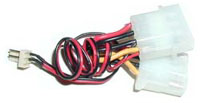 Both the FOP38 and WBK38 are equipped with an adapter with a Molex-connector for a usual 4-pin power supply connector. The majority of motherboards are equipped with three fan connectors, and it may be insufficient for connecting all required fans. So, here you need an adapter. InstallationWell, I should say that they both sit very rigidly! On the one hand, one may damage a CPU core while installing. But on the other hand, it improves a thermal contact of the heatsink base with a surface of the CPU core (a thermal paste layer will be very thin and evenly distributed on the core surface). And, as you can see, it stimulates more effective CPU cooling. The only worse drawback is that the clip construction doesn't allow mounting coolers by hand. You are necessary to use, for example, a screwdriver. Besides, there are certain problems with deinstallation of the FOP38 and WBK38. They are also directly connected with the clip's design. As for compatibility of the coolers with mainboards, I assure you that with Socket A ones you won't get into trouble (the FOP38 and WBK38 are intended for cooling CPU Duron/Athlon Socket A). With the PGA370 there is some problem. The FOP38 cooler is completely compatible with this socket. The WBK38 is installed on some boards with difficulty. Note that on the modern PGA370 boards from Asus and Abit such problems are far. If you are an owner of a Slot 1 card with FC-PGA processor and PGA370/Slot 1 adapters, I should disappoint you. The FOP38 can be installed, but at the same time it covers two DIMM connectors and stands right against the heatsink. The WBK38 can't be installed on Slot 1 mainboards in most cases because of huge dimensions of the cooler. TestsThe test system is following:
For good warming up of the CPU we are using burnp6 from the CPUBurn. And for temp control we have taken the Motherboard Monitor utility. Test results 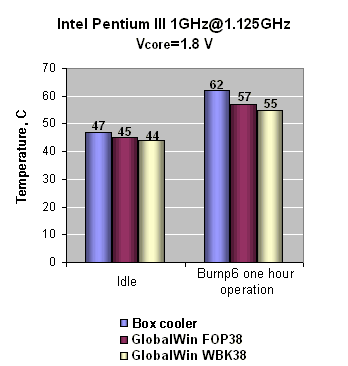 We used the MicroSi MPU 3.7 thermal grease. Before applying the grease we carefully cleaned the die surface and the heatsink base. The diagram shows max temp values in a stabilized mode. The temp near the heatsink was 28 C degrees (we measured it with a thermistor probe mounted 2.6 cm above the fan's center). Noise level is too high. Considering high rotation speed of the impeller (up to 7100 RPM according to the system monitor), it shouldn't be strange. And you can hear high-pitched noise from the fan engine on the background of rather quiet aerodynamic noise. The noise level can be reduced a bit if you would take off a fan guard and a proprietary sticker on the impeller. ConclusionIn terms of cooling efficiency the GlobalWin FOP38 coolers and especially GlobalWin WBK38 can take the lead! But there are some downsides preventing from it:
For those who are mainly concerned with effectiveness,
the choice is evident - the GlobalWin FOP38 and WBK38 coolers!
Write a comment below. No registration needed!
|
Platform · Video · Multimedia · Mobile · Other || About us & Privacy policy · Twitter · Facebook Copyright © Byrds Research & Publishing, Ltd., 1997–2011. All rights reserved. |